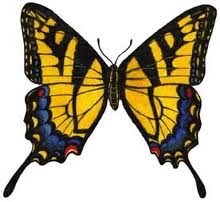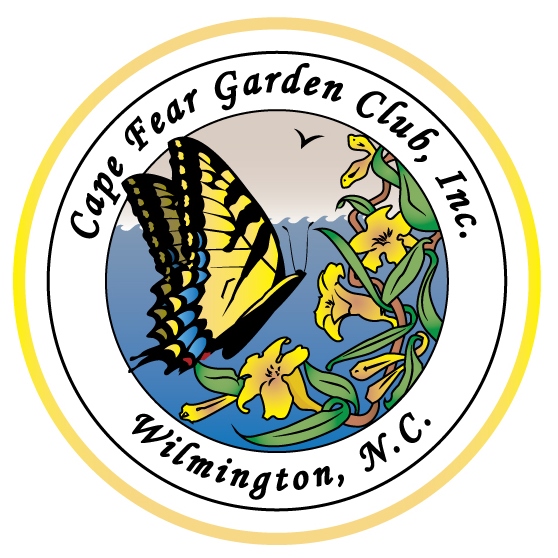 Eastern Tiger Swallowtail
Eastern Tiger Swallowtail
(Papilio Glaucus)
A North Carolina State Symbol
How did the Eastern Tiger Swallowtail Butterfly become a State Symbol?
Almost ten years ago, Cape Fear Garden Club, Inc. (CFGC) member Frances Baynor Parnell began researching the procedure for adopting a butterfly as a North Carolina State Symbol. North Carolina had established other State Symbols but unlike other states, had not named a butterfly. In early 2011, the original research file surfaced and Parnell presented the information to CFGC as possible club project. On October 10, 2011 CFGC Executive Committee voted to initiate the statewide effort to have a butterfly designated as a North Carolina State Symbol and “The Committee to Name the Eastern Tiger Swallowtail as a North Carolina State Symbol” was formed. After research by the CFGC Birds and Butterflies Committee, Conservation Committee, Gardening for Wildlife Committee and Youth Gardeners Committee, the Eastern Tiger Swallowtail Butterfly was selected. Parnell along with committee members Marie Ashworth and Ann Grose took the appeal statewide collecting letters of endorsement from butterfly enthusiasts across the state and from organizations including the North Carolina Wildlife Federation, Carolina Butterfly Society, Tidewater Camilla Club, Daniel Boone Gardens in Boone, Elizabethan Gardens in Manteo and local garden clubs from around the State. On April 29, 2012 the Garden Club of North Carolina, Inc., voted to adopt the project at their annual convention. In May 2012, committee members hosted a reception at the North Carolina General Assembly and were introduced at the opening of both houses. Committee members met with legislators and provided information on the impact of a State Butterfly Symbol on increasing the awareness and appreciation of North Carolina’s natural resources and ecosystems. These efforts gained the support of Senator Thomas Goolsby, District 9 and Representative Susi Hamilton, District 18, both of Wilmington, who agreed to sponsor Bill # SB236 to ratify the Eastern Tiger Swallowtail as the newest North Carolina State Symbol. The legislation found approval in both houses of the North Carolina General Assembly on Thursday June 7, 2012 and was signed into law by Governor Beverly Perdue on June 15, 2012.
Why nominate the Eastern Tiger Swallowtail Butterfly?
Approximately 175 species of butterflies are known to reside in North Carolina. Most of these breed in our state while some breed elsewhere and migrate into the state. The Eastern Tiger Swallowtail is one of the most recognized and commonly seen species due to its size and beauty. With a wingspan of 3 to 5.5 inches, bright yellow color with black tiger stripes, it commands our attention. In the central and western parts of the state the female swallowtail can be dark with a bit of yellow with blue on her hind wings or yellow with black stripes and blue on the hind wings, while the male is always yellow with black stripes and less blue on the hind wings. It should be noted that the Eastern Tiger Swallowtail is found in all 100 counties of NC and is an easy butterfly to identify for the experienced lepidopterist, gardener, or a casual spectator, making it a natural selection to be the North Carolina State Butterfly Symbol.
Where does the Eastern Tiger Swallowtail live?
The Eastern Tiger Swallowtail does not favor one county over another. Common habitats include along the edges of deciduous or mixed woods, fields, rivers, creeks, roadsides, and gardens. They prefer open areas rather that shady areas. Because it has adapted to many different habitats and host plants it is not considered threatened.
What does the Eastern Tiger Swallowtail eat?
Remember that butterflies must eat in two different stages of their life one being a caterpillar and another as a butterfly. As a caterpillar they feed on specific plants including Tulip tree (Liriodendron tulipifera), Black Cherry (Prunus serotina), and Sweet bay (Magnolia virginiana). Nectar plants for the adult butterfly are very widespread, but the species prefers tall herbs such as Joe-pye-weed (Eupatorium spp.), ironweed (Vernonia spp.) and milkweed (Asclepias spp.). You will also find them sipping water and minerals from mud and possibly on dung and carrion.
When is the Eastern Tiger Swallowtail visible? The butterfly flies from Spring to Fall producing two to three broods in a year. Males are often seen flying high in search of females while females search out specific plants to lay their eggs. Their flight period ranges from early March to early October. In the Coastal Plain and Piedmont, the butterflies can be seen from early March to late May, and early June to mid-September. Mountain flights generally occur from mid-March to mid- or late June, and late June to early October. Adults are known to fly high above the ground, usually above the tree canopy.
Committee to Name the Eastern Tiger Swallowtail as a North Carolina State Symbol
Sponsored by Cape Fear Garden Club, Wilmington, NC
